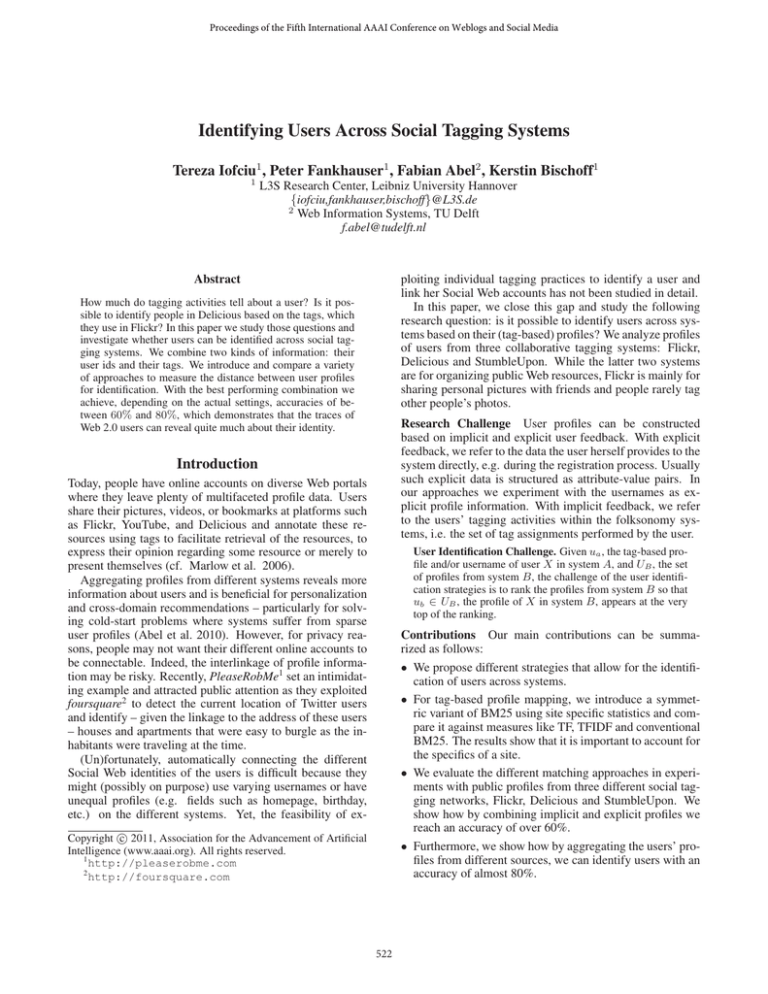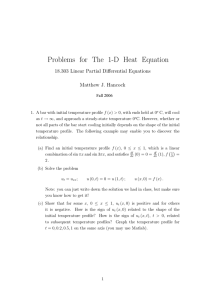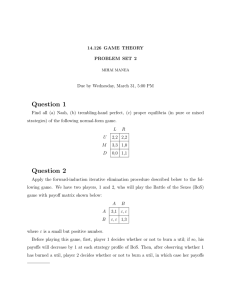
Proceedings of the Fifth International AAAI Conference on Weblogs and Social Media
Identifying Users Across Social Tagging Systems
Tereza Iofciu1 , Peter Fankhauser1 , Fabian Abel2 , Kerstin Bischoff1
1
L3S Research Center, Leibniz University Hannover
{iofciu,fankhauser,bischoff}@L3S.de
2
Web Information Systems, TU Delft
f.abel@tudelft.nl
ploiting individual tagging practices to identify a user and
link her Social Web accounts has not been studied in detail.
In this paper, we close this gap and study the following
research question: is it possible to identify users across systems based on their (tag-based) profiles? We analyze profiles
of users from three collaborative tagging systems: Flickr,
Delicious and StumbleUpon. While the latter two systems
are for organizing public Web resources, Flickr is mainly for
sharing personal pictures with friends and people rarely tag
other people’s photos.
Abstract
How much do tagging activities tell about a user? Is it possible to identify people in Delicious based on the tags, which
they use in Flickr? In this paper we study those questions and
investigate whether users can be identified across social tagging systems. We combine two kinds of information: their
user ids and their tags. We introduce and compare a variety
of approaches to measure the distance between user profiles
for identification. With the best performing combination we
achieve, depending on the actual settings, accuracies of between 60% and 80%, which demonstrates that the traces of
Web 2.0 users can reveal quite much about their identity.
Research Challenge User profiles can be constructed
based on implicit and explicit user feedback. With explicit
feedback, we refer to the data the user herself provides to the
system directly, e.g. during the registration process. Usually
such explicit data is structured as attribute-value pairs. In
our approaches we experiment with the usernames as explicit profile information. With implicit feedback, we refer
to the users’ tagging activities within the folksonomy systems, i.e. the set of tag assignments performed by the user.
Introduction
Today, people have online accounts on diverse Web portals
where they leave plenty of multifaceted profile data. Users
share their pictures, videos, or bookmarks at platforms such
as Flickr, YouTube, and Delicious and annotate these resources using tags to facilitate retrieval of the resources, to
express their opinion regarding some resource or merely to
present themselves (cf. Marlow et al. 2006).
Aggregating profiles from different systems reveals more
information about users and is beneficial for personalization
and cross-domain recommendations – particularly for solving cold-start problems where systems suffer from sparse
user profiles (Abel et al. 2010). However, for privacy reasons, people may not want their different online accounts to
be connectable. Indeed, the interlinkage of profile information may be risky. Recently, PleaseRobMe1 set an intimidating example and attracted public attention as they exploited
foursquare2 to detect the current location of Twitter users
and identify – given the linkage to the address of these users
– houses and apartments that were easy to burgle as the inhabitants were traveling at the time.
(Un)fortunately, automatically connecting the different
Social Web identities of the users is difficult because they
might (possibly on purpose) use varying usernames or have
unequal profiles (e.g. fields such as homepage, birthday,
etc.) on the different systems. Yet, the feasibility of ex-
User Identification Challenge. Given ua , the tag-based profile and/or username of user X in system A, and UB , the set
of profiles from system B, the challenge of the user identification strategies is to rank the profiles from system B so that
ub ∈ UB , the profile of X in system B, appears at the very
top of the ranking.
Contributions Our main contributions can be summarized as follows:
• We propose different strategies that allow for the identification of users across systems.
• For tag-based profile mapping, we introduce a symmetric variant of BM25 using site specific statistics and compare it against measures like TF, TFIDF and conventional
BM25. The results show that it is important to account for
the specifics of a site.
• We evaluate the different matching approaches in experiments with public profiles from three different social tagging networks, Flickr, Delicious and StumbleUpon. We
show how by combining implicit and explicit profiles we
reach an accuracy of over 60%.
• Furthermore, we show how by aggregating the users’ profiles from different sources, we can identify users with an
accuracy of almost 80%.
c 2011, Association for the Advancement of Artificial
Copyright Intelligence (www.aaai.org). All rights reserved.
1
http://pleaserobme.com
2
http://foursquare.com
522
Related Work
BM25 A well known weakness of the TFIDF weighting
scheme is that term frequency is not a very good indicator for the relevance of a term. If a document contains a
term 20 times, it is not 20 times as relevant as occurring
just once. Similarly, if a user assigns a tag 20 times, this
is not 20 times as relevant as assigning a tag just once.
Okapi BM25 (Spärck Jones, Walker, and Robertson 2000)
addresses this weakness by tempering term frequency such
that it quickly saturates with a maximum value.
The issue of identifying users via their interaction over the
web has been recently addressed in various application scenarios, such as personalization. Recent research mainly analyzed whether explicit profile information is sufficient to
identify users across system boundaries. For example, Carmagnola and Cena ( 2009) introduce an approach that bases
heuristics on profile attributes such as username, name, location or email address of a user. Vosecky, Hong, and Shen
(2009) examine explicit user profile information from two
similar social networking services to find which fields in
the profiles are best suitable for user cross-system identification. Zafarani and Liu (2009) connect user accounts across
12 communities exploiting explicit profile information.
Szomszor, Cantador, and Alani (2008) focus on implicit
tagging information. However, they do not aim to identify
users across tagging platforms, but their goal is to align tagbased profiles users have in Flickr and Delicious and assume
that linkage between different accounts of the same user is
given. Nevertheless, the authors propose an approach for
correlating tag clouds, which are filtered (to eliminate misspellings) and semantically enriched (e.g., via WordNet synonyms). We have implemented also their approach, but for
our task it led to a significant decrease in performance.
More generally, the problem of identifying users can be
regarded as an instance of duplicate detection – also known
as record linkage or entity resolution – a long standing problem in computer science. For a comprehensive overview on
the topic see Elmagarmid, Ipeirotis, and Verykios 2007. In
a sense the experiments described in this paper return to the
very root application domain of duplicate detection – identifying individuals – though under quite different circumstances. By tagging and other forms of interactions, Web 2.0
users provide a rich but fairly noisy trace, which as we will
show can be readily exploited for identifying them.
Site specific IDF and BM25 Tagging behavior is influenced highly by the site’s domain and design choices.
People tag differently music items, images or Web resources (Bischoff et al. 2008). For example, in our experimental dataset “tools” is used for more than half of
the resources in Delicious, but only few times in Flickr,
conversely, “arts” is used very often in Flickr, and rarely
in Delicious. Hence, “tools” is a very discriminative tag
when matching against Flickr, while “arts” discriminates
well against profiles in Delicious. As a consequence the document frequency of particular tags may differ substantially
among the sites. For the same reason of dependency on system design choices like tagging rights, object type and ownership, etc. (Marlow et al. 2006), also profile lengths may be
very different. Thus, we suggest to use BM25 together with
a site specific IDF and site specific average profile lengths:
w(u, t, s)
=
T F (u, t, s)
=
IDF (t, s)
=
T F (u, t, s) ∗ IDF (t, s)
c(t, u) ∗ (k1 + 1)
c(t, u) + k1 ∗ (1 − b + b ∗
max(0, log
|u|
)
avgU (s)
N (s) − n(t, s) + c
)
n(t, s) + (1 − c)
(1)
Thereby, T F takes into account the site specific profile
length avgU (s) and IDF takes into account the site specific document frequency of a tag n(t, s). As shown below,
this approach leads to significantly improved matching.
Matching Users based on Explicit Usernames
Matching Users across Sites
Often, the username is the only explicit and publicly available user attribute common to various tagging systems. A
straightforward approach for identifying users across systems is to analyze their usernames (Zafarani and Liu 2009).
We apply the following string similarity metrics: exact match, Jaccard similarity at character level, Levenshtein similarity (minimum number of editing operations required to transform one string into another string), SmithWaterman similarity (the costs of aligning two strings by
comparing segments of all possible lengths between two
strings) and Longest Common Substring (LCS), a variation
to Levenshtein distance allowing only addition and deletion.
Matching Users based on their Tags
For identifying users across social systems based on their
tagging behavior, we experiment with standard techniques
like TF, TFIDF and BM25 and compare it against a new
symmetric variant of BM25 using site specific statistics.
Baselines One of the most straightforward approaches to
match tag user profiles exploits tag frequencies. We evaluate
this approach as one baseline (TF). However, this approach
does not take into account the specificity of tags. Tags used
by many users such as “web” contribute much less evidence
for a match than more specific tags such as “NYC”. To take
into account tag specificity, frequency is typically combined
with the inverse document frequency of a tag. Since together
with the vector space model it is a standard method in Information Retrieval, we evaluate this approach as another baseline (TFIDF).
Each user profile u is modeled as a vector, where each
dimension contains the TF or TFIDF value of tag t ∈ T . The
matching score of two profiles u1 and u2 is then determined
by the cosine distance between their weighted vectors.
Matching Users based on Combined Profiles
Now we present approaches to merge different sources of
user information, first by combining implicit and explicit
profile information and, second, by aggregating profiles
from two systems to map against a third system.
Combining Username and Tags In order to combine the
different types of profiles, tag- and username-based, we use
a mixture model:
w(u1 , u2 )
523
= λ ∗ wt (u1 , u2 ) + (1 − λ) ∗ wu (u1 , u2 )
(2)
where wt (u1 , u2 ) is the normalized score obtained based
on the tags the user assigned, as presented above; and
wu (u1 , u2 ) is the string similarity of the usernames of the
two users. As the BM25 scores are not normalized between
0 and 1, we scale them to the same range as the scores on
username similarity by dividing them with the maximum
score of all compared user tag profiles between two systems.
Thereby the choice of λ indeed reflects the relative importance of the two scores used for matching.
offer the least overlap as for more than 40% the overlap is
0%. The small overlaps of individual profiles indicate that
user identification based on tagging is not trivial.
Metrics To measure the quality of the user profile rankings we use MRR and S@k. MRR (Mean Reciprocal Rank)
indicates at which rank the correct profile occurs on average.
The Success at rank k (S@k) stands for the mean probability
that the correct profile occurs within the top k of the ranked
results. In case of tied scores between the correct user profile pair and some other pairs, we penalized both metrics by
dividing them by the number of tied scores.
Aggregated Profiles Our evaluation will show that matching accuracy via tags depends heavily on the number of tags
given by a user. Hence, we create an aggregated tag-based
user profile by considering all the tags a user has assigned in
two systems, on which the user is already identified (e.g. via
explicit links on her profile page). Therefore, we accumulate
the tag frequencies of the corresponding profiles and then
apply the same comparison approaches for matching users
between the aggregated profile and a third system as presented above. For creating an aggregated username-based
profile from two systems, we consider the two usernames
as matching candidates. When calculating the distance between the aggregated username profile and a third profile we
select the highest matching username pair.
Results
Matching Users based on Tags Table 1 compares the
various approaches for identifying users. Regarding tagbased profiles (profile type: tag), BM25 clearly outperforms
TFIDF, and BM25 with site specific IDF also clearly outperforms BM25 with global IDF. This suggests that accounting
for site and domain specific characteristics in tag weighting
is promising. All methods yield substantially better results
than the baseline approach using TF with cosine similarity,
BM25 with site specific IDF improves its S@1 by even 2.5
times. By operating on a larger set of users (cf. FD column)
the chance of a mismatch increases for all metrics. However,
the relative ordering is consistent. BM25 with site specific
IDF (k1 = 3.75, b = 1, and c = 1) outperforms all other
approaches and looking at MRR it is less influenced by the
higher number of users. Evidently, there exists a strong correlation between profile size and matching accuracy (0.93).
Evaluation
Method and Metrics
The user identification algorithms have to find for each user
profile the corresponding profile that refers to the same user
in another system, i.e. each algorithm is tested in different
settings which are given by the different service constellations. For example, (i) given the Flickr profile of user u, the
algorithm has to rank Delicious profiles so that u’s Delicious
profile appears at the very top of the ranking.
Matching Users based on Username Regarding usernames (Table 1, username), Levenshtein and the Longest
Common Subsequence (LCS) based distance perform fairly
similar and outperform both Jaccard and Smith-Waterman
distances as well as the ExactMatch baseline. Success rates
(S@k) increase only slightly with increasing k, whereas they
increase fairly substantially depending on k for matching
based on users’ tags. This is to be expected. User names
tend to be much more unique than the tags assigned by users.
For the best metric (LCS), string similarity works well for
approximately 55% of the users but fails for the other 45%.
Dataset To investigate the questions above, we crawled
public profiles of 421,188 distinct users via the Social Graph
API3 , which makes information about connections between
different user accounts of a user available. However, only
a few users linked the profiles they have at social tagging
platforms. Among these users, 1467 people had a Flickr and
Delicious profile (FD dataset) and only 321 users had a tagbased profile at all three systems, i.e. Flickr and Delicious
and StumbleUpon (FDS dataset).
A remarkable feature of the dataset is that only a few tags
occur in more than one service: less than 20% of the distinct
tags were used in more than one system. For each user and
each pair of services we compute the overlap as the number
of distinct tags that occur in both profiles. The Delicious and
StumbleUpon profiles have the biggest overlap. However,
the overlap is rather small: for more than 50% of the users
the overlap of their Delicious and StumbleUpon profiles is
less than 20% and there exist only 6 users for whom the
overlap is slightly larger than 50%. It is interesting that the
overlap is so small, as in Delicious and StumbleUpon the
same type of resources are tagged, probably the tools are
used for separate tasks. Flickr and StumbleUpon profiles
3
Matching Users based on Tags and Username When
combining the best performing measures for the two types
of profiles (Table 1, combined), i.e. BM25 with site specific IDF (tag-based) and LCS (username-based), we gain
major improvements of 35% compared to the approaches
that exploit just the tag-based profiles and of 8.9% compared to the username-based approaches. Furthermore, we
analyzed how the user identification strategies perform for
the different service settings: all approaches work best when
comparing profiles from StumbleUpon and Delicious while
they are less successful when Flickr is involved. Regarding matching based on tag-based profiles, this result is to
be expected considering that the type of resources differ between these systems.However, a remarkable observation is
that many users also tend to use similar usernames on StumbleUpon and Delicious as the success of the username-based
http://code.google.com/apis/socialgraph/
524
Table 1: Results based on user tags, username and mixture for Flickr, Delicious and StumbleUpon (FDS dataset); for FDS
aggregated profiles; and for Flickr and Delicious (FD dataset). All improvements are significant (p<0.05, 2-tailed t-test)
Profile type
Strategy
MRR
S@1
FDS
S@3
S@10
MRR
FDS-aggregation
S@1
S@3
S@10
MRR
S@1
S@3
S@10
tags
TF
TFIDF
BM25
BM25 specific IDF
0.181
0.267
0.301
0.345
0.126
0.207
0.242
0.291
0.180
0.277
0.317
0.360
0.278
0.380
0.405
0.443
0.335
0.391
0.453
0.259
0.326
0.393
0.356
0.414
0.474
0.470
0.505
0.560
0.108
0.184
0.259
0.343
0.070
0.124
0.204
0.250
0.110
0.197
0.274
0.330
0.178
0.302
0.370
0.428
username
ExactMatch
Jaccard
SmithWaterman
Levenshtein
LCS
0.387
0.535
0.462
0.574
0.582
0.372
0.501
0.357
0.552
0.552
0.375
0.536
0.475
0.572
0.586
0.375
0.577
0.607
0.591
0.600
0.555
0.684
0.437
0.721
0.727
0.542
0.654
0.217
0.701
0.701
0.547
0.686
0.476
0.722
0.731
0.547
0.717
0.747
0.735
0.746
0.555
0.684
0.437
0.571
0.564
0.542
0.654
0.217
0.459
0.452
0.547
0.686
0.476
0.496
0.502
0.547
0.717
0.747
0.524
0.535
combined
Mixture
0.677
0.641
0.697
0.728
0.816
0.792
0.832
0.855
0.632
0.543
0.590
0.624
approach (LCS) is higher than 70%, whereas it is less successful (S@1 < 50%) for Flickr profiles.
FD
our new approach of BM25 in combination with site specific IDF outperformed the other approaches significantly
and (3) knowing more about the user (profile aggregation)
and combining tag- and username-based approaches further
improves the performance significantly to an accuracy of almost 80% and nearly 90% for specific settings.
While our user identification strategies can support crosssystem personalization, they raise privacy concerns. For future work, we plan to study such privacy aspects in more
detail. We will also investigate whether the consideration of
network structure (such as friend links) in combination with
tag-based profile features impacts user identification.
Using aggregated profiles Table 1 (FDS-aggregation)
also compares the various approaches for matching aggregated profiles, i.e. the union of two individual profiles for
a given user. We compare each aggregated profile with
the remaining profile (e.g. Flickr-Delicious to StumbleUpon, Delicious-StumbleUpon to Flickr, etc.) and viceversa. Regarding aggregated tag profiles, BM25 with site
specific IDF leads again to a significant improvement over
IDF and BM25 with global IDF. In summary, knowing more
(tags) about a user improves user identification performance
clearly. For example, S@1 improves from 0.291 to 0.393 for
BM25 with site specific IDF.
Correspondingly, aggregated username-based profiles allow for improving the performance. For example, S@1 increases from 0.552 to 0.701 for the Levenshtein and LCS
measures (Table 1, username, FDS-aggregation). Finally,
for the mixture approach that combines the best tag- and
username-based user identification strategies, we also see
that having more user information increases the precision of
the user identification challenge significantly. For the aggregated profiles, the mixture of the tag-based BM25 approach
using site specific IDF and LCS for measuring similarity of
usernames leads to the best performance of 0.816 and 0.792
regarding MRR and S@1 respectively. Moreover, it is interesting to see that for all settings where Flickr profiles are
unified with Delicious or StumbleUpon profiles, the combination of tag- and username-based strategies achieves a
success (S@1) of nearly 90%.
Acknowledgments The work was partially funded by the
NTH (Niedersächsische Technische Hochschule) School for
IT Ecosystems as well as the Crokodil project funded by the
German Federal Ministry of Education and Research and the
European Social Fund of the European Union (ESF).
References
Abel, F.; Henze, N.; Herder, E.; and Krause, D. 2010. Interweaving
public user profiles on the web. In Proc. UMAP, 16–27.
Bischoff, K.; Firan, C. S.; Nejdl, W.; and Paiu, R. 2008. Can all
tags be used for search? In Proc. CIKM 2008, 193–202.
Carmagnola, F., and Cena, F. 2009. User identification for crosssystem personalisation. Information Sciences: an International
Journal 179(1-2):16–32.
Elmagarmid, A. K.; Ipeirotis, P. G.; and Verykios, V. S. 2007.
Duplicate record detection: A survey. Knowledge and Data Engineering, IEEE Transactions on 19(1):1–16.
Marlow, C.; Naaman, M.; Boyd, D.; and Davis, M. 2006. HT06,
tagging paper, taxonomy, flickr, academic article, to read. In Proc.
Hypertext 2006, 31–40. ACM.
Spärck Jones, K.; Walker, S.; and Robertson, S. E. 2000. A probabilistic model of information retrieval: development and comparative experiments. parts 1 and 2. Information Processing and Management 36:779–840.
Szomszor, M.; Cantador, I.; and Alani, H. 2008. Correlating user
profiles from multiple folksonomies. In Proc. Hypertext, 33–42.
Vosecky, J.; Hong, D.; and Shen, V. Y. 2009. User identification
across multiple social networks. In Int. Conference on Networked
Digital Technologies (NDT ’09), 360 –365.
Zafarani, R., and Liu, H. 2009. Connecting corresponding identities across communities. In Proc. ICWSM, 354–357.
Conclusions and Future Work
In this paper we investigate whether users can be identified
across Web platforms by analyzing their tagging practices.
Therefore, we examine user profiles from three different social tagging services: Flickr, Delicious and StumbleUpon.
We exploit implicit feedback (tagging behavior) as well as
lightweight explicit profile information (usernames) to construct user profiles for identifying the users. In summary,
we conclude that (1) it is possible to identify users across
systems based on their tagging behavior even though the
tagging behavior varies considerably between the analyzed
systems, (2) for the user identification based on tag profiles
525





